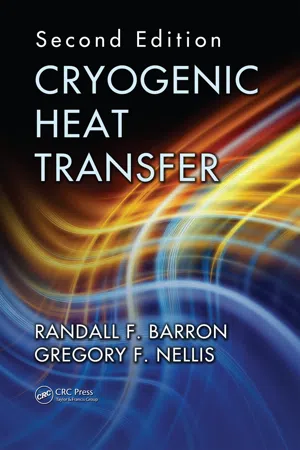
Cryogenic Heat Transfer
Randall F. Barron, Gregory F. Nellis
- 682 pages
- English
- ePUB (adapté aux mobiles)
- Disponible sur iOS et Android
Cryogenic Heat Transfer
Randall F. Barron, Gregory F. Nellis
À propos de ce livre
Cryogenic Heat Transfer, Second Edition continues to address specific heat transfer problems that occur in the cryogenic temperature range where there are distinct differences from conventional heat transfer problems. This updated version examines the use of computer-aided design in cryogenic engineering and emphasizes commonly used computer programs to address modern cryogenic heat transfer problems. It introduces additional topics in cryogenic heat transfer that include latent heat expressions; lumped-capacity transient heat transfer; thermal stresses; Laplace transform solutions; oscillating flow heat transfer, and computer-aided heat exchanger design. It also includes new examples and homework problems throughout the book, and provides ample references for further study.
New in the Second Edition:
-
- Expands on thermal properties at cryogenic temperatures to include latent heats and superfluid helium
- Develops the material on conduction heat transfer and divides it into four separate chapters to facilitate understanding of the separate features and computational techniques in conduction heat transfer
- Introduces EES (Engineering Equation Solver), a computer-aided design tool, and other computer applications such as Maple
- Describes special features of heat transfer at cryogenic temperatures such as analysis with variable thermal properties, heat transfer in the near-critical region, Kapitza conductance, and network analysis for free-molecular heat transfer
- Includes design procedures for cryogenic heat exchangers
Cryogenic Heat Transfer, Second Edition discusses the unique problems surrounding conduction heat transfer at cryogenic temperatures. This second edition incorporates various computational software methods, and provides expanded and updated topics, concepts, and applications throughout. The book is designed as a textbook for students interested in thermal problems occurring at cryogenic temperatures and also serves as reference on heat transfer material for practicing cryogenic engineers.
Foire aux questions
Informations
1
Introduction
1.1 Introduction
- Effects of variable material properties. The transport properties of materials generally vary significantly in the cryogenic temperature range (Frost 1975, p. 9). For example, the specific heat of solids at low temperatures varies as the third power of the absolute temperature; in contrast, the specific heats of metals at about room temperature may vary by less than 5% for a temperature change of up to 100°F. Constant property analysis may be valid for many ambient temperature applications but is often inaccurate when applied to cryogenic heat transfer problems.
- Thermal insulation. All of the cryogenic liquids have a relatively small heat of vaporization (see Table 1.1). For example, the heat of vaporization associated with liquid nitrogen is only 199.3 kJ/kg (85.7 Btu/lbm) at a pressure of 1 atm. Conversely, the heat of vaporization of water at 1 atm is 2257 kJ/kg (970 Btu/lbm). Because of liquefaction costs, safety considerations, and low heat of vaporization, special high-performance insulations are required to reduce the evaporation rate of cryogenic liquids in storage vessels. The thermal conductivity of multilayer insulations (MLIs) used in cryogenic systems is approximately 1000× smaller than the thermal conductivity of the fiberglass insulation that is commonly used in the thermal insulation of residences.
- Near-critical-point convection. The thermodynamic critical pressure for many cryogenic fluids (e.g., hydrogen and helium) is much lower than the critical pressure associated with most conventional fluids (e.g., water). Convective heat transfer at near-critical and super-critical conditions is therefore encountered more frequently in cryogenic systems than it is in systems operating at ambient or elevated temperatures.
- Thermal radiation problems. The wavelength at which the peak radiant intensity occurs for blackbody radiation is inversely proportional to the absolute temperature according to Wien’s law. For example, at 1 K the peak occurs at a wavelength of 2.9 mm (or about 0.1 in.). Most metallic shields that are used to reduce radiation heat transfer in cryogenic systems will have thicknesses that are comparable to or less than this value. As a result, the treatment of radiation problems at cryogenic temperature can be very different than if the materials were near room temperature where the wavelength peak occurs at about 0.01 mm (or 0.0004 in.).
- Heat exchan...